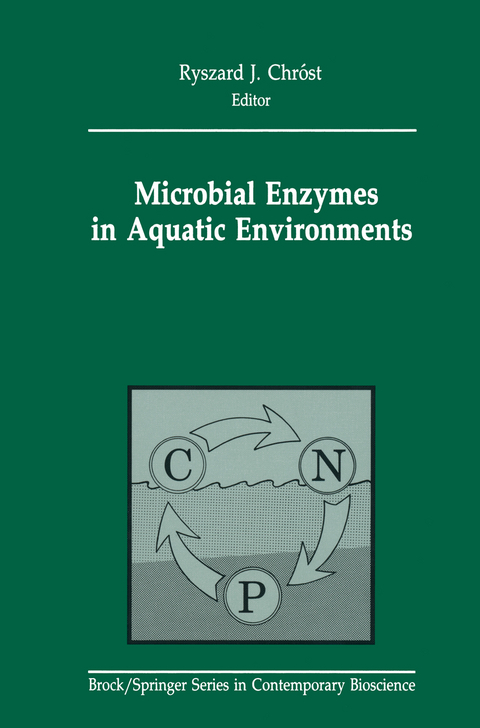
Microbial Enzymes in Aquatic Environments
Springer-Verlag New York Inc.
978-1-4612-7793-4 (ISBN)
1 Early Studies on Ecto- and Extracellular Enzymes in Aquatic Environments.- References.- 2 Extracellular Enzymatic Interactions: Storage, Redistribution, and Interspecific Communication.- 2.1 Extracellular Enzymes: Their Position Relative to the Cell in the Environment.- 2.2 Strategy of External vs. “Free” Enzymes.- 2.3 Immobilization of Enzyme Activity.- 2.4 Humic Loadings to Fresh Waters.- 2.5 Regulation of Enzyme Activity in Aquatic Ecosystems.- 2.6 Summary Conclusions.- References.- 3 Environmental Control of the Synthesis and Activity of Aquatic Microbial Ectoenzymes.- 3.1 Introduction.- 3.2 Experimental Design.- 3.3 Ectoenzyme Location in Bacteria.- 3.4 Alkaline Phosphatase.- 3.5 ?-Glucosidase.- 3.6 Leucine Aminopeptidase.- 3.7 Control of Ectoenzyme Synthesis and Activity—Conclusions.- References.- 4 Microbial Extracellular Enzyme Activity: A New Key Parameter in Aquatic Ecology.- 4.1 Introduction.- 4.2 Methods and Experimental Design.- 4.3 Activity of Bacteria Attached to Detritus.- 4.4 Activity of Bacteria Attached to Inorganic Surfaces.- 4.5 Depth Profile of Aminopeptidase Activity.- 4.6 Importance of Extracellular Enzyme Activity in Microbial Activity in Marine Ecosystems.- References.- 5 Ecological Aspects of Enzymatic Activity in Marine Sediments.- 5.1 Introduction.- 5.2 Methodological Approach.- 5.3 Localization of Extracellular Enzymes.- 5.4 Spatial Distribution of Enzymatic Activity in Sediments.- 5.5 Regulation of Enzymatic Activity in Sediments.- 5.6 Conclusions.- References.- 6 Extracellular Enzyme Activity in Eutrophic and Polyhumic Lakes.- 6.1 Introduction.- 6.2 Environmental Characteristics of the Studied Lakes.- 6.3 DOM Composition and Dynamics.- 6.4 DOM-Enzyme Interactions.- 6.5 ?-Glucosidase Studies.- 6.6 Aminopeptidase Studies.- 6.7 Enzyme Endo- and Exo-Cleaving Mechanisms and Synergistic Action.- 6.8 Environmental and Regulatory Aspects of Microbial Extracellular Enzyme Activity.- 6.9 Position and Importance of Extracellular Enzymes in Detritus Processing.- References.- 7 Protein Degradation in Aquatic Environments.- 7.1 Introduction.- 7.2 Experimental Studies of the Kinetics of Protein Degradation.- 7.3 Modelling Bacterial Growth on Complex Organic Matter.- References.- 8 Peptidase Activity in River Biofilms by Product Analysis.- 8.1 Introduction.- 8.2 Methods and Experimental Design.- 8.3 Results.- 8.4 Discussion.- References.- 9 Aminopeptidase Activity in Lakes of Differing Eutrophication.- 9.1 Introduction.- 9.2 Methods.- 9.3 Results and Discussion.- References.- 10 Role of Ecto-Phosphohydrolases in Phosphorus Regeneration in Estuarine and Coastal Ecosystems.- 10.1 Introduction.- 10.2 Study Areas.- 10.3 Methods and Experimental Design.- 10.4 Physicochemistry of the Three Ecosystems.- 10.5 Phosphohydrolytic Activity and Phosphorus Regeneration.- 10.6 Significance of Microbial Ecto-phosphohydrolases in Estuarine and Coastal Waters.- References.- 11 Bacterial Phosphatases from Different Habitats in a Small, Hardwater Lake.- 11.1 Introduction.- 11.2 Methods and Experimental Design.- 11.3 Results.- 11.4 Discussion.- References.- 12 Phosphatase Activity in an Acid, Limed Swedish Lake.- 12.1 Introduction.- 12.2 Methods and Environmental Analyses.- 12.3 Results.- 12.4 Discussion.- References.- 13 Phosphatase Activities in Lake Kinneret Phytoplankton.- 13.1 Introduction.- 13.2 Sampling.- 13.3 Results and Discussion.- References.- 14 Filtration and Buoyant Density Characterization of Algal Alkaline Phosphatase.- 14.1 Introduction.- 14.2 Methods.- 14.3 Results and Discussion.- References.- 15 Cyclic Nucleotide Phosphodiesterase Activity in Epilimnetic Lake Water.- 15.1 Introduction.- 15.2 Methods.- 15.3 Results and Discussion.- References.- 16 Chitinase Activity in Estuarine Waters.- 16.1 Introduction.- 16.2 Study Location and Methods.- 16.3 Chitinase Assay.- 16.4 Chitinase Activity in Water and Sediments.- 16.5 Significance of Chitinolytic Activity in Aquatic Environments—Conclusions.- References.- 17 Significance of Extracellular Enzymes for Organic Matter Degradation and Nutrient Regeneration in Small Streams.- 17.1 Introduction.- 17.2 Methods and Experimental Design.- 17.3 Results and Discussion.- References.- 18 Enzyme Activities in Billabongs of Southeastern Australia.- 18.1 Introduction.- 18.2 Methods and Experimental Design.- 18.3 Results.- 18.4 Discussion.- References.- 19 Hydrolytic Activities of Organisms and Biogenic Structures in Deep-Sea Sediments.- 19.1 Introduction.- 19.2 Methods.- 19.3 Results and Discussion.- References.
| Reihe/Serie | Brock Springer Series in Contemporary Bioscience |
|---|---|
| Zusatzinfo | XVIII, 317 p. |
| Verlagsort | New York, NY |
| Sprache | englisch |
| Maße | 155 x 235 mm |
| Themenwelt | Naturwissenschaften ► Biologie ► Evolution |
| Naturwissenschaften ► Biologie ► Mikrobiologie / Immunologie | |
| Naturwissenschaften ► Biologie ► Ökologie / Naturschutz | |
| ISBN-10 | 1-4612-7793-0 / 1461277930 |
| ISBN-13 | 978-1-4612-7793-4 / 9781461277934 |
| Zustand | Neuware |
| Informationen gemäß Produktsicherheitsverordnung (GPSR) | |
| Haben Sie eine Frage zum Produkt? |
aus dem Bereich


